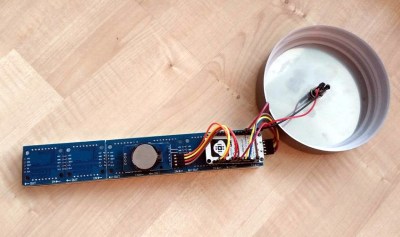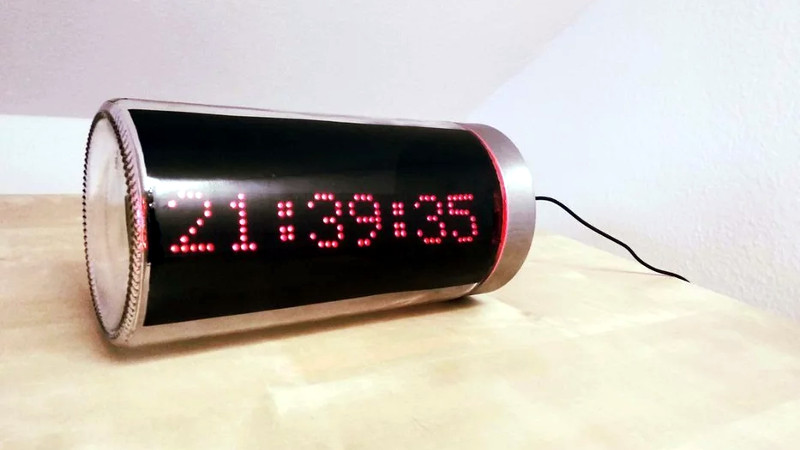Ironically, with the wide availability of modular electronic components today, the hardest part of constructing your latest gadget might just end up being able to find a decent looking enclosure for it. Project boxes will only get you so far, and let’s be honest, they aren’t exactly the most attractive things in the world. But if you’re willing to think outside the box (get it?) there are some unconventional options out there that might fit the bill.
 Take for example this ESP8266 clock by [ZaNgAbY] that’s housed in a glass pasta jar. With the addition of some window tint film for the LED display to shine through, the final result could nearly pass as modern art. Even if you don’t need an extra clock around the house, this same general principle could be used to create a slick-looking ticker for all sorts of information, from the weather to server uptime with just some adjustments to the code.
Take for example this ESP8266 clock by [ZaNgAbY] that’s housed in a glass pasta jar. With the addition of some window tint film for the LED display to shine through, the final result could nearly pass as modern art. Even if you don’t need an extra clock around the house, this same general principle could be used to create a slick-looking ticker for all sorts of information, from the weather to server uptime with just some adjustments to the code.
Inside the jar there’s six 8×8 MAX7219 LED matrix modules tacked together to create one long strip, with a NodeMCU board stuck to the back with double-sided tape. There’s also a DS3231 RTC module so the clock can keep halfway decent time, but depending on how aggressively you are willing to pull down the current time from NTP, that may or may not be required. A simple barrel jack is popped through the metal lid of the jar for power, and represents the only physical connection the internals have to the outside world.
For the next iteration [ZaNgAbY] is thinking of adding a temperature and humidity sensor, and a light sensor that can dim the LED display depending on the ambient light. While the environmental sensors will have to go on the outside of the lid if there’s any hope of pulling useful readings from them, the clear glass will allow him to keep the light sensor internal to the clock.
Believe it or not, this isn’t the first time we’ve seen somebody give their electronics the pickle treatment. We’ve previously played host to a server that “preserves” files in a Mason jar, as well as a gorgeous display of an iPod under glass.
[Thanks to Baldpower for the tip.]
















I like that – nice and simple
Part of the mystery of “ship in a bottle” is “how did they get it in there”?
Not even a passing reference to Jim Croce’s “Time in a Bottle”? Missed opportunity!
https://m.youtube.com/watch?v=AnWWj6xOleY
Kids these days and their new fangled rock music…
LOL, I’m 40 so Croce was before my time, but I wondered exactly the same thing! Missed opportunity.
I’m 40 too, but grew up with a dad who always listened to the “oldies” station. Now that they have 80’s music on the “oldies” station, I think the cycle is complete.
That was my first thought, but then this comment would have been replaced with one saying they were promised a bottle and got a jar. Can’t please em all.
It’s HaD…. you can’t please anyone!
Came here to see this comment. Leaving satisfied.
Glad you enjoy my project :)
Lose the wire. Fill with batteries, but, located for a CG that holds it at “time.” Slight roll-pull towards you ignites a display for day-date. Let loose, it rolls back to time. Lid becomes a transducer-soeaker for an alarm. Maybe as a gift, it sounds each precious minute of the reciever’s birthday. Maybe a beep or tune on holidays. Wires? So… 60’s.
Code is from https://github.com/schreibfaul1/ESP8266-LED-Matrix-Clock with hardcoded 2 second NTP offset, needed as it does not actually implement NTP (have not seen an implementation for ESP8266 yet that actually does it) – so you might as well get the time from any HTTP request header…
Caution on that RTC DS3231 board.
This board’s original design included a so-called “charging circuit”. Unfortunately, it was just feeding VCC through a diode and resistor to the top of the battery.
“Charging circuit” with a LIR series rechargeable battery:
* at VCC 5 VDC it would damage the LIR;
* at VCC 3.3 VDC it wouldn’t properly charge the LIR.
“Charging circuit” with a CR series non-rechargeable battery:
* This would swell and destroy the battery, and if not noticed that could include exploding and/or blowing a hole and shooting across the room.
For safe/reliable operation, people had to modify, remove or disable the “charging circuit”, which fortunately was simple to do.
My board came without the “charging” diode and resister, so the “charging circuit” is already defunct/absent.
Good for blinking an LED once a second:
With VCC at 3.3 VDC, enable SQW output for square wave at 1 Hz for PPS (Pulse Per Second) on a Pi 3 with “sudo i2cset -y -f 1 0x68 0xE 0x00”. This writes value 0x00 to address 0xE on device 0x68 on I2C bus 1.
I built this scroller in an acrylic case… I’ll try this clock project with my daughter but with the acrylic I used in my project. https://www.hackster.io/wizworks/wifi-marquee-scroller-e68977